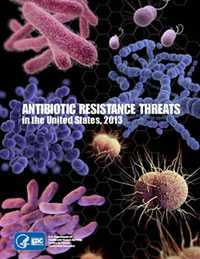Fast Facts
Español: Datos breves
Facts about Antibiotic Resistance
- Antibiotic resistance is one of the world’s most pressing public health problems.
- Every time a person takes antibiotics, sensitive bacteria are killed, but resistant ones may be left to grow and multiply.
- Overuse of antibiotics is a major modifiable cause of increases in drug-resistant bacteria.
- Overuse and misuse of antibiotics threatens the usefulness of these important drugs. Decreasing inappropriate antibiotic use is a key strategy to control antibiotic resistance.
- Antibiotic resistance in children and older adults are of particular concern because these age groups have the highest rates of antibiotic use.
- Antibiotic resistance can cause significant suffering for people who have common infections that once were easily treatable with antibiotics.
- When antibiotics do not work, infections often last longer, cause more severe illness, require more doctor visits or longer hospital stays, and involve more expensive and toxic medications. Some resistant infections can even cause death.

The Antibiotic resistance threats in the United States, 2013 report gives a first-ever snapshot of the burden and threats posed by the antibiotic-resistant germs having the most impact on human health. Read the report.
Antibiotic Prescribing: Attitudes, Behaviors, Trends and Cost
- At least 30% of antibiotic courses prescribed in the outpatient setting are unnecessary, meaning that no antibiotic is needed at all. Most of this unnecessary use is for acute respiratory conditions, such as colds, bronchitis, sore throats caused by viruses, and even some sinus and ear infections 1.
- Total inappropriate antibiotic use (which includes unnecessary antibiotic use plus inappropriate antibiotic selection, dosing, and duration) may approach 50% of all outpatient antibiotic use 2, 3, 4.
- The number of antibiotic prescriptions written for children has decreased in recent years 2, 5, 6., but almost 30% of antibiotics prescribed to children are still unnecessary 1.
- Antibiotics cause 1 out of 5 emergency department visits for adverse drug events (ADEs) 7, 8. Antibiotics are the most frequent cause of ADEs leading to emergency department visits in children, and 7 of the top 10 drugs involved in ADEs leading to emergency room visits are antibiotics 9.
- We spent $10.7 billion on antibiotics in the United States in 2009, including $6.5 billion among patients who visit physician offices and $3.5 billion among hospitalized patients 10.
References
- Fleming-Dutra, K., et al. (2016). “Prevalence of Inappropriate Antibiotic Prescriptions Among US Ambulatory Care Visits, 2010-2011.” JAMA: the Journal of the American Medical Association 315(17): 1864-1873.
- Centers for Disease Control and Prevention (CDC). Office-related antibiotic prescribing for persons aged ≤14 years — United States, 1993—1994 to 2007—2008. MMWR Morb Mortal Wkly Rep. 2011;60(34):1153-6.
- Pichichero ME. Dynamics of antibiotic prescribing for children. JAMA. June 19, 2002;287(23):3133-5.
- Shapiro DJ, Hicks LA, Pavia AT, Hersh AL. Antibiotic prescribing for adults in ambulatory care in the USA, 2007-09. J Antimicrob Chemother. 2014;69(1):234-40.
- Vaz LE, Kleinman KP, Raebel MA, Nordin JD, Lakoma MD, Dutta-Linn MM, Finkelstein JA. Recent trends in outpatient antibiotic use in children. Pediatrics. 2014;133(3):375-85.
- CDC. Antibiotic Resistance Patient Safety Atlas. https://gis.cdc.gov/grasp/PSA/indexAU.html
- Bourgeois FT, Mandl KD, Valim C, Shannon MW. Pediatric adverse drug events in the outpatient setting: An 11-year national analysis. Pediatrics. 2009;124(4):e744-50.
- Budnitz DS, Pollock DA, Weidenbach KN, Mendelsohn AB, Schroeder TJ, Annest JL. National surveillance of emergency department visits for outpatient adverse drug events. JAMA. 2006;296(15):1858-66.
- Shehab, N., et al. (2016). “US emergency department visits for outpatient adverse drug events, 2013-2014.” JAMA 316(20): 2115-2125.
- Suda KJ, Hicks LA, Roberts RM, Hunkler RJ, Danziger LH. A national evaluation of antibiotic expenditures by healthcare setting in the United States, 2009. J Antimicrob Chemother. 2013;68(3):715-18.
- Page last reviewed: December 22, 2016
- Page last updated: December 22, 2016
- Content source:


 ShareCompartir
ShareCompartir